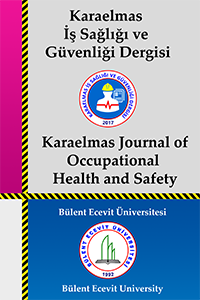Evaluation of Patients Admitted to the Emergency Department of Kafkas University Faculty of Medicine Hospital due to Occupational Accidents
Occupational accidents and illnesses are the most important problem in the business sector in all regions of the world, and about 160 million people are affected by occupational accidents annually worldwide. The evaluation of patients admitted to the emergency departments of hospitals due to occupational accidents is of special importance for reducing these accidents. In this study, patients admitted to the Emergency Department of Kafkas University Research and Training Hospital with occupational injuries were evaluated. It was observed that 38 patients applied to the emergency department because of occupational accidents between the specified dates. The mean age of these patients was 35.7±10.4 years. It was determined that 40.5% of the patients had occupational accidents between 08:00-12:00. Most of the occupational accidents occurred on Monday and Saturday. Injuries of the upper extremity (28.95%) and head/neck (28.95%) were the most common injuries. Occupational accidents are common in the emergency department and play an important role in mortality and morbidity. First aid and occupational accident training should be provided to workers to prevent frequent accidents during working hours. We believe that due to the widespread of head/neck and upper extremity injuries, strict inspections of workers to ensure protective measures (such as clothing, gloves, helmets) will significantly reduce occupational accidents.
Anahtar Kelimeler:
Occupational accidents, Trauma, Injury, Emergency Department
Evaluation of Patients Admitted to the Emergency Department of Kafkas University Faculty of Medicine Hospital due to Occupational Accidents
Occupational accidents and illnesses are the most important problem in the business sector in all regions of the world, and about 160 million people are affected by occupational accidents annually worldwide. The evaluation of patients admitted to the emergency departments of hospitals due to occupational accidents is of special importance for reducing these accidents. In this study, patients admitted to the Emergency Department of Kafkas University Research and Training Hospital with occupational injuries were evaluated. It was observed that 38 patients applied to the emergency department because of occupational accidents between the specified dates. The mean age of these patients was 35.7±10.4 years. It was determined that 40.5% of the patients had occupational accidents between 08:00-12:00. Most of the occupational accidents occurred on Monday and Saturday. Injuries of the upper extremity (28.95%) and head/neck (28.95%) were the most common injuries. Occupational accidents are common in the emergency department and play an important role in mortality and morbidity. First aid and occupational accident training should be provided to workers to prevent frequent accidents during working hours. We believe that due to the widespread of head/neck and upper extremity injuries, strict inspections of workers to ensure protective measures (such as clothing, gloves, helmets) will significantly reduce occupational accidents.
Keywords:
Occupational Accidents, Trauma, Injury, Emergency Department,
___
- Karadeniz, O. (2012). Dünya'da ve Türkiye'de İş Kazaları ve Meslek Hastalıkları ve Sosyal Koruma Yetersizliği. Calisma ve Toplum, 34(3).
- Jilcha, K., & Kitaw, D. (2016). A LITERATURE REVIEW ON GLOBAL OCCUPATIONAL SAFETY AND HEALTH PRACTICE & ACCIDENTS SEVERITY. International Journal for Quality Research, 10(2).
- Hämäläinen, P., Takala, J., & Kiat, T. B. (2017). Global estimates of occupational accidents and work-related illnesses 2017. World, 2017, 3-4.
- Rushton, L. (2017). The global burden of occupational disease. Current environmental health reports, 4(3), 340-348.
- Dagli, B., & Serinken, M. (2012). Occupational injuries admitted to the emergency department/Acil servise basvuran is kazalarina bagli yaralanmalar. The Journal of Academic Emergency Medicine, 167-171.
- Ceylan, H. (2011). Türkiye’deki iş kazalarının genel görünümü ve gelişmiş ülkelerle kıyaslanması. Uluslararası Mühendislik Araştırma ve Geliştirme Dergisi, 3(2), 18-24.
- Yardım, N., Çipil, Z., Vardar, C., & Mollahaliloğlu, S. (2007). Türkiye iş kazaları ve meslek hastalıkları: 2000-2005 yılları ölüm hızları. Dicle Tıp Dergisi, 34(4), 264-271.
- Kekeç, Z., Ünalan, D., Şenol, V., & Çetinkaya, F. (2003). Erciyes üniversitesi Tıp Fakültesi Acil Servisine başvuran iş kazalarının değerlendirilmesi. Fırat Üniversitesi Sağlık Bilimleri Tıp Dergisi, 17, 277-83.
- Satar, S., Kekeç, Z., Sebe, A., & Sarı, A. (2004). Çukurova Üniversitesi Tıp Fakültesi acil tıp anabilim dalına başvuran iş kazası olgularının analizi.
- Ozkan, S., Kilic, S., Durukan, P., Akdur, O., Vardar, A., Geyik, S., & İkizceli, İ. (2010). Occupational injuries admitted to the Emergency Department. Ulus Travma Acil Cerrahi Derg, 16(3), 241-7.
- T.C. Sosyal Güvenlik Kurumu [Internet]. [a.yer 23 Eylül 2019]. Erişim adresi: http://www.sgk.gov.tr/wps/portal/sgk/tr/kurumsal/istatistik/sgk_istatistik_yilliklari
- Gürcanlı, E. (2013). İnşaat Sektöründe Gerçekleşen Ölüm ve Yaralanmalarin Analizi. TTB Mesleki Sağlık ve Güvenlik Dergisi, 13(48), 20-29.
- Güven, F. M. K., Bütün, C., Beyaztaş, F. Y., Eren, Ş. H., & Korkmaz, İ. (2009). Cumhuriyet Üniversitesi Tıp Fakültesi Hastanesi'ne başvuran adli olguların değerlendirilmesi.
- BIRGEN, N., YAVUZ, M. S., & OKYAY, M. (2001). İŞ KAZASI OLGULARININ ADLİ TIP AÇISINDAN DEĞERLENDİRİLMESİ. Turkish Journal of Forensic Medicine, 15(2), 14-18.
- Yayın Aralığı: Yılda 3 Sayı
- Başlangıç: 2017
- Yayıncı: Zonguldak Bülent Ecevit Üniversitesi
